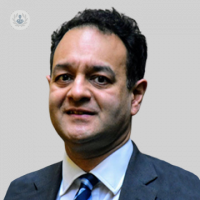Sleep apnoea: symptoms, causes, and treatments
Written in association with:
Obstructive Sleep Apnoea (OSA) is a disorder characterised by pauses in breathing or periods of shallow breathing during sleep, which results in irregular breathing at night, sleep fragmentation and intermittent oxygen dips.
These can contribute to the manifestations such as excessive sleepiness during the day and other health implications. It usually manifests as snoring, excessive daytime sleepiness and witnessed pauses in breathing during sleep. It's prevalence is 4% of middle-aged men and 3% of women in the general population, but much higher in predisposed individuals.

Causes of sleep apnoea
The causes of sleep apnoea depend on a combination of risk factors such as; the predisposing structure of the upper airway, the brain’s threshold for awakening and what the degree of breathing response to an obstructed airway is.
Risk factors for sleep apnoea
- Obesity - strongest risk factor.
- Obese children - they have a higher prevalence and severity of OSA
- Male gender.
- Middle age - 55-59 in men, 60-64 in women.
- Smoking.
- Sedative drugs including sleeping tablets.
- Excess alcohol consumption.
- Family history.
- Possible genetic tendency
Symptoms of sleep apnoea (usually a combination)
- Loud snoring
- Choking or gasping during sleep
- Feeling short of breath on waking
- Daytime fatigue
- Other associations (cognitive decline, atrial fibrillation)
Investigation of Sleep Apnoea
An evaluation of the history - symptoms, sleep schedule and confounders, risk factors, associated conditions (i.e cardiovascular disease, diabetes mellitus) should be undertaken, ideally with the bed partner. A sleep specific questionnaire (to assess these elements and daytime function), and sleep diary are often helpful.
An overnight sleep study is then carried out, which involves measuring elements of SCOPER (i.e. sleep, cardiovascular, oxygen saturation, position, effort of respiration, respiratory flow) is undertaken to determine the presence and severity of the OSA. In selected cases, drug induced sleep endoscopy (DISE) can simulate sleep whilst observing the changes in calibre of the upper airway. This can help determine types of treatment likely to benefit the patient.
Treatment of sleep apnoea
After evaluation and diagnosis, if the patient is symptomatic or has a moderate or severe degree of sleep apnoea, they will benefit from treatment to maintain the patency of the upper airway during sleep.
The best established treatment is CPAP, associated with lifestyle changes. A few people may benefit from surgery to the upper airway to remove soft tissue (e.g. large tonsils).
Different treatment options include:
- Continuous Positive Airflow Pressure (CPAP) – an airflow generator provides a constant gentle stream of air through a tube and mask over the mouth and/or nose- this keeps the breathing passages open.
- Dental devices (mandibular advancement device) – to reposition the lower jaw and tongue.
- Surgery – (soft tissue or hard tissue) after other treatments have failed. Options may include tissue removal, jaw repositioning, implants or, in severe cases, creating a new air passageway (tracheostomy).
Snoring vs. sleep apnoea
Snoring does not cause sleep apnoea. However, it is an important symptom. Simple snoring does not usually lead to excessive daytime sleepiness (EDS). If snoring is accompanied by EDS, or witnessed pauses in breathing at night, then sleep disordered breathing, such as sleep apnoea may exist.
Is sleep apnoea curable?
A careful clinical, diagnostic and airway assessment, which identifies reversible risk factors (e.g. such as being overweight, large tonsils, blocked nose or sedatives) can help determine which types may be curable. Supporting and re-establishing the patency of the upper airway, whilst reversing risk factors can lead to cure in some cases.



